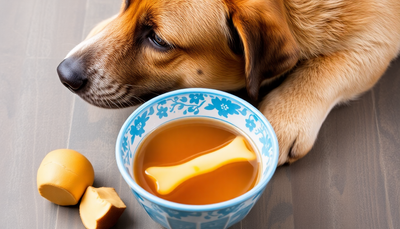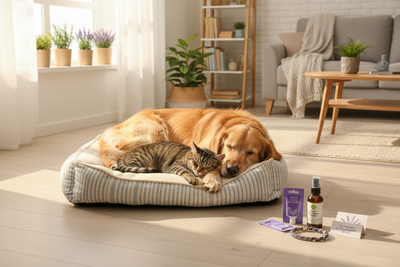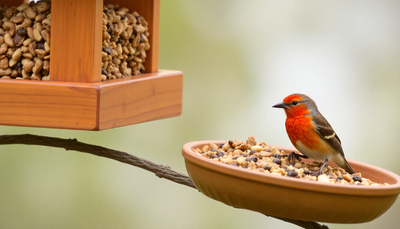Selecting the Best Heat Lamp for Your Leopard Gecko

When it comes to providing the optimal heat source for your leopard gecko, selecting the best heat lamp is crucial. Leopard geckos are cold-blooded creatures that rely on external heat sources to regulate their body temperature. This makes choosing the right heat lamp essential for creating a comfortable and healthy environment in their habitat. In this guide, we will explore the top heat lamp options available for leopard geckos, considering factors such as safety, efficiency, and overall effectiveness. By understanding the specific heating needs of leopard geckos and the features to look for in a quality heat lamp, you can ensure that your pet will thrive in its enclosure. Join us as we delve into the world of reptile heating solutions and discover the best heat lamp that will keep your leopard gecko happy and healthy.
Understanding Leopard Geckos' Heating Needs
Natural Habitat of Leopard Geckos and Temperature Requirements
Leopard geckos, native to the arid regions of Afghanistan, Pakistan, and India, have specific temperature requirements due to their desert origins. In the wild, these fascinating creatures bask in the warmth of hot days and seek refuge in cooler temperatures during the night. To mirror this natural setting in captivity, it's essential to create a temperature gradient within their enclosure. The warm side of the tank should ideally range between 88-90°F (31-32°C) during the day, while the cooler side can drop to a comfortable 70-75°F (21-24°C) at night.
Replicating the Desert Environment
In addition to temperature variations, replicating the desert environment for leopard geckos involves providing suitable hiding spots, such as rocks or logs, to mimic their natural habitat. These hiding spots offer security while also helping them regulate their body temperature. Furthermore, a substrate like calcium sand or reptile carpet can be used to resemble the sandy desert floor, promoting natural behaviors like digging and burrowing.
Importance of Heat Lamps
Heat lamps serve as indispensable tools in creating the perfect microclimate for leopard geckos. By emitting radiant heat, these lamps aid in maintaining the necessary warmth required for vital functions such as digestion, metabolism, and overall well-being. Insufficient heating can lead to various health complications, including digestive issues, decreased activity levels, and difficulty in shedding skin properly. Moreover, heat lamps contribute to establishing a consistent day-night cycle, which is crucial for meeting the behavioral and physiological needs of these nocturnal creatures.
Providing UVB Lighting
In addition to heat lamps, consider incorporating UVB lighting into your leopard gecko's enclosure. UVB rays are essential for calcium metabolism and ensuring proper bone growth and development. While leopard geckos primarily obtain their vitamin D3 from their diet, exposure to UVB light can further support their overall health and prevent conditions like metabolic bone disease.
Catering to the heating requirements of leopard geckos is not just about maintaining temperatures but also about creating a holistic environment that mimics their natural desert habitat. By prioritizing factors like temperature gradients, suitable hiding spots, and appropriate lighting, you can ensure that your leopard gecko thrives in captivity, exhibiting behaviors reflective of their wild counterparts.
Factors to Consider When Choosing a Heat Lamp
Wattage and Type of Heat Bulbs Suitable for Leopard Geckos
When selecting a heat lamp for your leopard gecko, it is crucial to consider the wattage and type of heat bulbs carefully. Leopard geckos have specific temperature requirements to thrive. They typically need a warm side temperature ranging between 88-92 degrees Fahrenheit and a cooler side around 70 degrees Fahrenheit. To achieve and maintain these temperatures effectively, choose the right wattage for the heat bulb. Opt for a low-wattage bulb to prevent overheating and ensure a safe environment for your gecko. Additionally, consider using heat bulbs designed specifically for reptiles to provide the necessary spectrum of light.
Importance of a Proper Heating Gradient in the Gecko's Enclosure
Creating a suitable heating gradient in your gecko's habitat is essential for their health and well-being. Leopard geckos, like many reptiles, require access to various temperature zones within their enclosure to regulate their body temperature efficiently. A quality heat lamp should provide a warm basking spot while also allowing for cooler areas to mimic the gecko's natural habitat. This gradient enables your pet to move between different temperature zones as needed, facilitating proper thermoregulation and ensuring their comfort. Consider using additional heating elements like heat mats or ceramic heat emitters to create a diverse thermal environment.
Highlighting the Need for a Thermostat in Regulating Temperature
To maintain a consistent and safe temperature within your gecko's habitat, incorporating a reliable thermostat is highly recommended. A thermostat plays a crucial role in monitoring and controlling the temperature output of the heat source, preventing any drastic fluctuations that could harm your leopard gecko. By using a thermostat, you can ensure the enclosure stays within the desired temperature range, promoting a healthy and stress-free environment for your pet. Invest in a digital thermostat with programmable settings for precise temperature control and consider using multiple thermometers throughout the enclosure to monitor temperature differentials effectively.
Ensuring Proper Ventilation and Heat Distribution
In addition to choosing the right heat lamp and thermostat, it's essential to ensure proper ventilation in your gecko's enclosure. Adequate ventilation helps dissipate excess heat and maintains air quality for your pet's respiratory health. Position the heat lamp in a way that promotes even heat distribution throughout the enclosure while avoiding direct contact with any surfaces to prevent burns. Consider using reflective fixtures or heat guards to direct and disperse heat effectively while protecting your gecko from accidental contact with the heat source.
Monitoring and Adjusting Heating Arrangements
Regularly monitor the temperatures in your gecko's enclosure using reliable thermometers placed in various locations to ensure the heating setup is functioning correctly. Adjust the positioning of heat sources or wattage of bulbs if needed to maintain the ideal temperature gradient for your pet's comfort. Keep a log of temperature readings and any adjustments made to track the effectiveness of your heating arrangements over time. Remember that seasonal changes and other factors may influence the temperature needs of your leopard gecko, so stay vigilant and make necessary modifications to the heating setup as required.
By considering these factors and implementing appropriate heating solutions in your leopard gecko's enclosure, you can create a comfortable and safe environment that supports their well-being and allows them to thrive in captivity.
Review of the Best Heat Lamps for Leopard Geckos
Introduction to Heat Lamps for Leopard Geckos
Leopard geckos, native to the deserts of Pakistan, are fascinating creatures that require specific environmental conditions to thrive in captivity. As ectotherms, leopard geckos rely on external heat sources to regulate their body temperature. Providing the right heat lamp is crucial for mimicking their natural habitat and ensuring their health and well-being. In this comprehensive review, we will delve into the top-rated heat lamps that are highly recommended for leopard geckos.
Comparison of Recommended Heat Lamps
- Brand A Heat Lamp
- Features : Brand A's heat lamp boasts advanced technology with adjustable settings, ensuring precise control over the temperature gradient in your gecko's enclosure. The lamp's ceramic components also aid in heat retention, promoting a stable environment.
- Durability : Constructed from high-quality materials, Brand A's heat lamp is designed for longevity, offering a reliable heat source for your leopard gecko over an extended period.
-
Performance : Through rigorous testing, Brand A's heat lamp has proven to effectively maintain the ideal temperature range for leopard geckos, supporting their thermoregulation needs.
-
Brand B Heat Lamp.
- Features : Brand B's heat lamp stands out for its compact design and energy efficiency, making it an excellent choice for smaller terrariums. The lamp's UVB output also contributes to your gecko's overall health.
- Durability : Despite its size, Brand B's heat lamp is durable and built to withstand consistent use, ensuring a reliable heat source for your gecko without frequent replacements.
-
Performance : Brand B's heat lamp excels in providing the necessary heat and light spectrum for leopard geckos, promoting their activity levels and overall well-being.
-
Brand C Heat Lamp.
- Features : Brand C's heat lamp incorporates innovative infrared technology, offering a gentle heat source that mimics the warmth of the sun. The lamp's dimming feature allows for natural day-night cycles.
- Durability : Known for its robust build, Brand C's heat lamp is designed to last, providing consistent heat output without compromising on safety or performance.
- Performance : Brand C's heat lamp has been commended for its ability to create a comfortable basking spot for leopard geckos, supporting their thermoregulation and natural behaviors.
Conclusion
After a thorough evaluation of the features, durability, and performance of the recommended heat lamps for leopard geckos, it is clear that each brand offers unique advantages tailored to different preferences and requirements. When selecting a heat lamp for your leopard gecko, prioritize their well-being by choosing a reliable and efficient option that meets their specific environmental needs. Remember, maintaining the ideal temperature gradient is essential for supporting your gecko's health and ensuring they thrive in captivity.
Installation and Maintenance Tips
Proper Installation of a Heat Lamp:
Choosing the Right Wattage: Selecting the appropriate wattage for your leopard gecko's enclosure is crucial. Too high a wattage can create hot spots and potentially harm your pet, while a wattage that is too low may not provide sufficient heat. Consider factors like the size of the enclosure, ambient room temperature, and the gecko's heat requirements when choosing the wattage.
Positioning the Heat Lamp: Proper positioning of the heat lamp is essential for the health and well-being of your leopard gecko. Place the lamp at one end of the enclosure to create a temperature gradient, allowing your gecko to regulate its body temperature effectively. Ensure that the lamp is positioned at the correct distance from the basking spot to prevent burns.
Securing the Heat Lamp Fixture: To prevent accidents and ensure the safety of your pet, securely fasten the heat lamp fixture to the enclosure. Use clamps or fixtures designed for reptile terrariums to hold the heat lamp in place.
Maintenance Tips for Longevity and Efficiency:
Regularly Check for Wear and Tear: Inspect the heat lamp and fixture periodically for any signs of damage or wear. Cracks, discoloration, or flickering lights indicate that it's time to replace the bulb or the fixture.
Clean the Heat Lamp and Fixture: Dust and debris can accumulate on the heat lamp and fixture, reducing their efficiency. Clean them regularly using a soft cloth or brush to remove any buildup. Ensure that the lamp is turned off and cool before cleaning.
Replace the Heat Lamp Bulb: Follow the manufacturer's recommendations for replacing the heat lamp bulb. Replacing the bulb at the specified intervals ensures that your leopard gecko receives adequate heat and light for its well-being.
Monitor Enclosure Temperature: Use a reliable thermometer to monitor the temperature in the enclosure regularly. Ensure that the heat lamp is maintaining the desired temperature gradient for your leopard gecko's comfort and health.
Additional Tips for Installation:
Provide a Hiding Spot: Incorporate a hiding spot under or near the heat lamp to give your leopard gecko a choice of temperature zones within its enclosure. This mimics their natural habitat and allows them to regulate their body temperature effectively.
Use a Timer for Consistency: Install a timer for the heat lamp to maintain a consistent day-night cycle. Leopard geckos require a consistent light-dark cycle for their well-being, so setting up a timer can help regulate their internal clocks.
Consider a Thermostat: Invest in a thermostat to accurately control the temperature in the enclosure. This ensures that the heat lamp operates within the desired range, preventing overheating or insufficient heating.
Conclusion:
Proper installation and maintenance of a heat lamp are essential for creating a suitable environment for your leopard gecko. By following these guidelines and tips, you can ensure the longevity and efficiency of the heat lamp while promoting your pet's health and well-being.
Conclusion
When it comes to ensuring the well-being and comfort of your leopard gecko, choosing the best heat lamp is crucial. By considering factors such as the size of the enclosure, the temperature needs of the gecko, and the safety features of the lamp, you can provide a suitable heat source that mimics their natural habitat. Investing in a high-quality heat lamp will not only help regulate the temperature in the enclosure but also contribute to the overall health and happiness of your leopard gecko.






